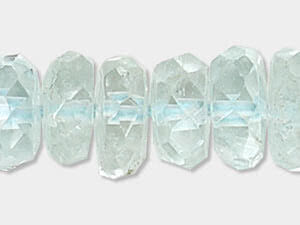Goshenite Meaning and Properties
Goshenite History
Goshenite is a colorless variety of the mineral beryl , and gets its name from the small town of Goshen, Massachusetts, where it was first discovered. Referred to as the "Mother of Crystals," goshenite meaning is also associated with motherhood. Goshenite was once used for the manufacturing of eyeglasses because of its excellent transparency. Though the gem value is relatively low, it is most commonly used for gemstone or metaphysical purposes, and considered as a source of beryllium. Beryllium is a chemical element used as a metal alloy for tool making. Beryllium is also used for windows for X-ray equipment as well as other applications.
What are the Metaphysical Properties of Goshenite?
Goshenite is believed to develop practical thought when making decisions, helping one see an argument from all angles and then take appropriate action. Goshenite is thought to be a gemstone that encourages truthfulness in all words and actions. Metaphysical beliefs hold that goshenite promotes self-control, creativity and originality. Goshenite meaning is linked to communication and resolving relationship misunderstandings.
Goshenite opens the crown and etheric chakras to stimulating the mental centers. Goshenite is not a birthstone , but is associated with the astrological sign of Gemini.
What is Goshenite Made From?
Goshenite is a member of the beryl family. Goshenite is an aluminum beryllium silicate mineral that forms in prismatic or vertically striated crystals, sometimes terminated by small pyramidal faces. Other beryl stones include morganite (pink), heliodor (yellow/yellow-green), aquamarine (blue-green), emerald (green) and maxixe (deep blue). Transparent to translucent, with a vitreous luster, goshenite is said to be the purest form of beryl, containing fewer impurities than the colored varieties.
Goshenite can be found all over the world including North and South America, China, Canada, Russia, Mexico, Colombia, Brazil, Northern Europe, Africa and Asia.
- Mineral Information: Variety of beryl
- Chemical Composition: Be3Al2(Si6O18)
- Color: Colorless
- Hardness: 7-1/2 to 8 (Mohs)
- Specific Gravity: 2.60 – 2.90
- Refractive Index: 1.562 – 1.615
How Do You Clean Goshenite?
Goshenite gemstones can be cleaned using room temperature water, mild soap and a nonabrasive cloth.
Goshenite FAQ
Q: Is goshenite only found in Massachusetts?
A: While goshenite was first found in Massachusetts in 1844, since then, it has been discovered all over the world.
Q: Is goshenite treated or enhanced?
A: With its natural crystal clarity, goshenite is not usually treated or enhanced.
Q: Is goshenite a beryl?
A: Goshenite is a form of beryl with very few inclusions, giving it an impressive crystal clarity.
Q: Was goshenite known as "poor man's diamond"?
A: Many gemstones have been referred to as the “poor man’s diamond,” such as zircon , moissanite, aquamarine, quartz crystal , marcasite , and more, including goshenite.
Q: Can goshenite be confused with other gemstones?
A: Goshenite can be mistaken for other gemstones. Any clear, colorless gemstone will bear at least a passing resemblance to goshenite. While goshenite tends to have a softer sheen compared to the brilliant sparkle of other clear, colorless gemstones, here are some of the key distinguishers among them:
- Goshenite: 7-1/2 to 8 Mohs hardness; glass-like clarity; subtle sheen rather than brilliant sparkle
- White Topaz: 8 Mohs hardness; known for its resemblance to diamond, although it is a softer stone
- Quartz Crystal: 7 Mohs hardness; can be translucent as well as transparent
- Diamond: 10 Mohs hardness; transparent with a brilliant sparkle in a single color
- Zircon: 6-1/2 to 7-1/2 Mohs hardness; transparent with a sparkle nearly comparable to diamond, with flashes of multicolored light
- Cubic Zirconia: 8 Mohs hardness; transparent lab-grown gemstone that usually lacks inclusions, giving it a sparkle that in some instances, outperforms diamond; weighs more than a diamond of the same size
Designing with Goshenite
For thousands of years, colorless beryl has been an ideal substitute for other colorless gemstones. Likewise, goshenite is used as imitation for diamonds and emeralds by applying silver or green metal foil. To simulate other valuable gems, doubles and triplets are constructed by layering sections with colored cement or a thin slice of a natural or synthetic gemstone.
Shop for Goshenite
**Please note that all metaphysical or healing properties listed are collected from various sources. This information is offered as a service and not meant to treat medical conditions. Fire Mountain Gems and Beads® does not guarantee the validity of any of these statements.
How did you like this resource? Your feedback helps us provide resources that matter to you most.
Copyright Permissions
All works of authorship (articles, videos, tutorials and other creative works) are from the Fire Mountain Gems and Beads® Collection, and permission to copy is granted for non-commercial educational purposes only. All other reproduction requires written permission. For more information, please email copyrightpermission@firemtn.com.

